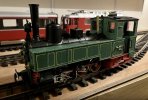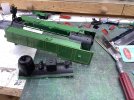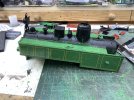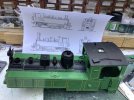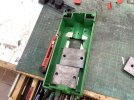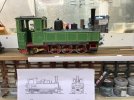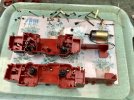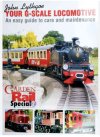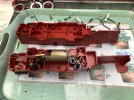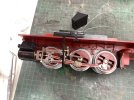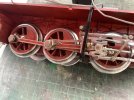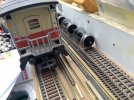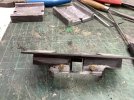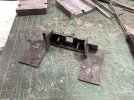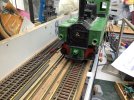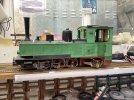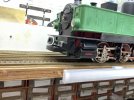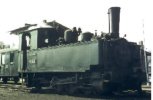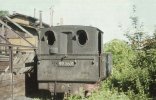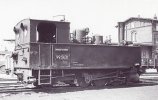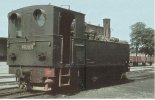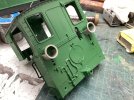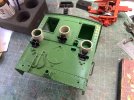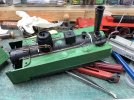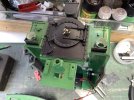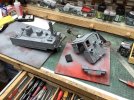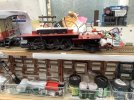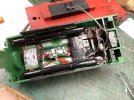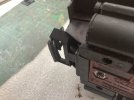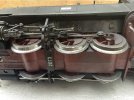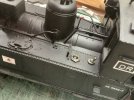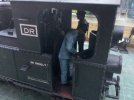Having got up to 5 battery jobs on one of my batteryfications threads, I decided it was perhaps time for a new thread as that one was getting pretty busy.
 www.gscalecentral.net
www.gscalecentral.net
A look at a U2 gave me thoughts, thus this desire for another Harz loco came about. I have long desired one of the 2 0-6-2t’s that graced the Harz lines between 1890 and the mid 1950’s(NWE 71/2 becoming DR 99 5631/2). Though both moved on before my selected timeframe of 1981, I can live with a little imagination.
I have not found any pictures of them, but there is a good set of drawings available. The likeness to the U2 drew my thoughts around converting one of them and I had purchased a rather nice black sound fitted one a year or two back for the job.
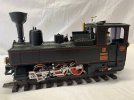
However this was so nice that I did not have the heart to hack it about and it currently lives on my loft railway. However when a non working cheepo one became available on the forum I decided to take a punt.
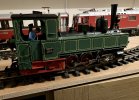
This became the likely donor, as I expected there was not much wrong with it besides a part trashed valve gear. Once this was removed the motor whired happily turning the wheels so ‘let the hacking begin’. Work will require some repairs/bodgelling to the valve gear on one side, not beyond my abilities I hope.
A cursory look at the drawing indicated major surgery below the cab with the U2 steps and bits needing to be removed to reveal the rear bogie. Note sundry bits all over the workbench, a very thorough strip down was needed for this project.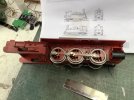
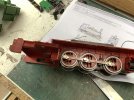
Below reveals the removed bits, more would need to go later.
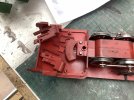
Having done that it was metal bashing time as the bogie needed some detail. Here you can see the U shaped piece to hold the detail including springs to the former naked bogie. You can see also the already cut brass side-frame that parts they will be attached to.
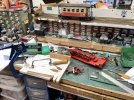
Next I found a couple of rather nice brass lost wax castings to fit the bill, the other 2 had been used on a Gauge 3 Wagon.
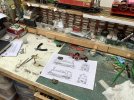
I cleaned up the back of the castings, carefully drilled and tapped them for 8ba screws to hold on to the extension detail piece. That has been silver soldered to the U shape with the 8ba screws passing through both into the spring unit. Note the holes in the bogie for 10ba screws to hold it all in place.
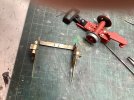
Here you can see the assembly fitted to the bogie, the spring assembly is a little large but I can live with that. Key part is it works and passes through R1 still, well it did once the step detail was removed.
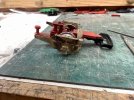
Seen in place on the chassis. The weights really have to be in place as the spring on the bogie lifts the rear w heels considerably without them. More thinking for further on with the conversion.
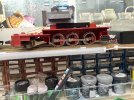
Sundry Battery Conversions. Swiftsixteen Railcar Railbus battery fit Piko 35008, IP Jessie fit. LGB 2092 Fosworks. Piko class 80 Also Piko 35008
There was a thread about these some time back. https://www.gscalecentral.net/threads/swiftsixteen-railcars.314263/ I have had a sort of long time longing for one but never got round to buying one before they went off the market for a while. They appear to be available again, though may never...
A look at a U2 gave me thoughts, thus this desire for another Harz loco came about. I have long desired one of the 2 0-6-2t’s that graced the Harz lines between 1890 and the mid 1950’s(NWE 71/2 becoming DR 99 5631/2). Though both moved on before my selected timeframe of 1981, I can live with a little imagination.
I have not found any pictures of them, but there is a good set of drawings available. The likeness to the U2 drew my thoughts around converting one of them and I had purchased a rather nice black sound fitted one a year or two back for the job.

However this was so nice that I did not have the heart to hack it about and it currently lives on my loft railway. However when a non working cheepo one became available on the forum I decided to take a punt.

This became the likely donor, as I expected there was not much wrong with it besides a part trashed valve gear. Once this was removed the motor whired happily turning the wheels so ‘let the hacking begin’. Work will require some repairs/bodgelling to the valve gear on one side, not beyond my abilities I hope.
A cursory look at the drawing indicated major surgery below the cab with the U2 steps and bits needing to be removed to reveal the rear bogie. Note sundry bits all over the workbench, a very thorough strip down was needed for this project.


Below reveals the removed bits, more would need to go later.

Having done that it was metal bashing time as the bogie needed some detail. Here you can see the U shaped piece to hold the detail including springs to the former naked bogie. You can see also the already cut brass side-frame that parts they will be attached to.

Next I found a couple of rather nice brass lost wax castings to fit the bill, the other 2 had been used on a Gauge 3 Wagon.

I cleaned up the back of the castings, carefully drilled and tapped them for 8ba screws to hold on to the extension detail piece. That has been silver soldered to the U shape with the 8ba screws passing through both into the spring unit. Note the holes in the bogie for 10ba screws to hold it all in place.

Here you can see the assembly fitted to the bogie, the spring assembly is a little large but I can live with that. Key part is it works and passes through R1 still, well it did once the step detail was removed.

Seen in place on the chassis. The weights really have to be in place as the spring on the bogie lifts the rear w heels considerably without them. More thinking for further on with the conversion.


